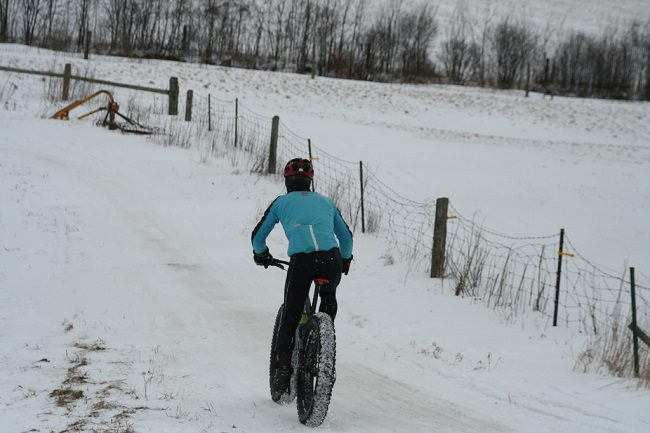More Canadians “Viking biking” during the winter months, experts say, but some still fear the season
For many Canadian cyclists, something very satisfying happens when they saddle up as the temperatures plummet. When the snow starts falling, these riders don't retreat.


For many Canadian cyclists, something very satisfying happens when they saddle up as the temperatures plummet. When the snow starts falling, these riders don’t retreat. Some of them, affectionately referring to how their passion suits the season as “viking biking,” simply trade lyrca for thicker layers, and smoother tires for more tread.
The satisfaction — something these riders meet with a wink, both literally and figuratively — is the look of passing pedestrians and motorists that says, wordlessly, “Are you out of your mind?”
In an article published November 15, the CBC tackled that very question.
One expert cited by the article, Tom Babin — a Calgary-based writer who penned a book titled Frostbike: The Joy, Pain and Numbness of Winter Cycling — says that the number of those die-hard, ice-defying cyclists is growing by the year. Undeterred by the harshness of a Canadian winter, their numbers, he estimates, represent around 30 to 40 percent of the total number of cyclists — all of whom are surprised by the ease, he says, of getting around on two wheels during the presumed off season.
“I don’t think we’re ever going to get the same number of people riding in the winter that do in the summer,” Babin conceded, “but every time I speak to someone who tried it, [they] said it’s a lot easier than they thought it would be.” His own experience as a rider in winter, he added, underscores the notably growing appeal of biking in winter. As always, it comes down to the experience of cycling itself.
“It’s quiet, the snow is faling — it can have really beautiful moments,” Babin told the CBC. “And it’s good for me, it gets me exercise, and it lets me see my city in a better way.”
Yvonne Bambrick, meanwhile — a Toronto-based writer, cyclist and cycling advocate, and the author of The Urban Cycling Survival Guide— suggests that there are practical, but no less meaningful, reasons for the appeal of cycling during the winter months. In Toronto, the presence of snow, even a bit of it, can snarl traffic and slow down a transit system already notorious for delays. Cycling, she says, gives an individual more control over the unruly, unreliable conditions of the season.
“The predictable travel times are worth their weight in gold,” Bambrick said. “You know how long it’s going to get from point A to point B.”
Of course, many still haven’t taken to the saddle in winter for the usual, predictable reasons: there’s a fear of what winter can mean in terms of transportation, with low traction on roads and even lower visibility making the experience of bike commuting in the city — something intimidating to many would-be commuters — even more daunting.
To some, the CBC argued, it certainly seems more dangerous, but it’s difficult to tell whether or not that’s even the case. Records indicate that most cycling deaths happen during the spring and summer months, when there are more riders in total on the road. In the winter, those same Ontario records show, the number of riders killed on the roads amount to only nine per cent — and that’s a number accounting for four years, between 2006 and 2010.
Babin agrees. In the Alberta cyclist’s opinion, a fear of what the season can bring, however unfounded, is the reason why there are fewer cyclists on the streets during the winter. That fear, however, is somewhat self-inflicted. In general, it’s an effect of a certain kind of cloistered, insular attitude about the colder months, made worse by only ever seeing winter through a frost-caked living room window.
“We’ve really lost our connection to winter,” he said, “because we’ve gotten so good at avoiding it. You really can go all winter without ever getting outside and I think that sort of bred a bit of fear in all of us.”
